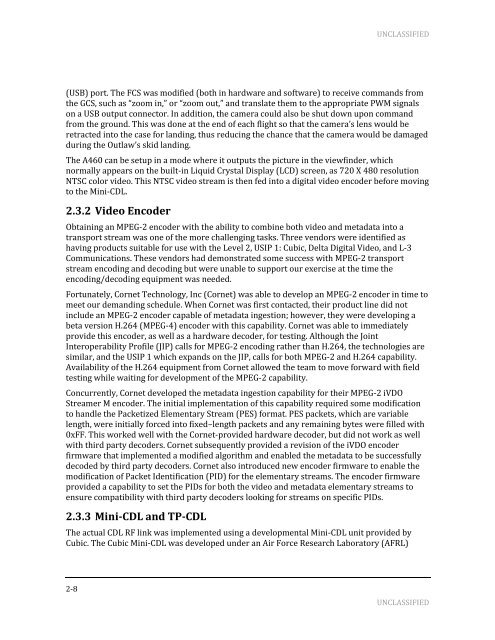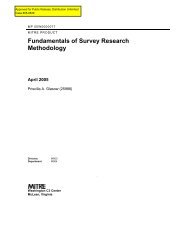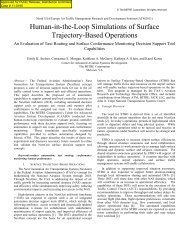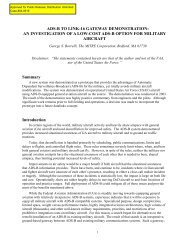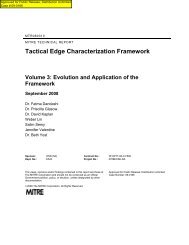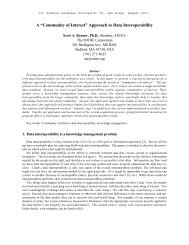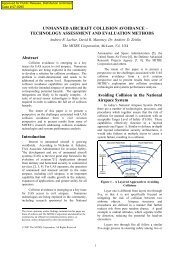Unmanned Aircraft System (UAS) Exercise to Assess ... - Mitre
Unmanned Aircraft System (UAS) Exercise to Assess ... - Mitre
Unmanned Aircraft System (UAS) Exercise to Assess ... - Mitre
Create successful ePaper yourself
Turn your PDF publications into a flip-book with our unique Google optimized e-Paper software.
2-8<br />
UNCLASSIFIED<br />
(USB) port. The FCS was modified (both in hardware and software) <strong>to</strong> receive commands from<br />
the GCS, such as “zoom in,” or “zoom out,” and translate them <strong>to</strong> the appropriate PWM signals<br />
on a USB output connec<strong>to</strong>r. In addition, the camera could also be shut down upon command<br />
from the ground. This was done at the end of each flight so that the camera’s lens would be<br />
retracted in<strong>to</strong> the case for landing, thus reducing the chance that the camera would be damaged<br />
during the Outlaw’s skid landing.<br />
The A460 can be setup in a mode where it outputs the picture in the viewfinder, which<br />
normally appears on the built-in Liquid Crystal Display (LCD) screen, as 720 X 480 resolution<br />
NTSC color video. This NTSC video stream is then fed in<strong>to</strong> a digital video encoder before moving<br />
<strong>to</strong> the Mini-CDL.<br />
2.3.2 Video Encoder<br />
Obtaining an MPEG-2 encoder with the ability <strong>to</strong> combine both video and metadata in<strong>to</strong> a<br />
transport stream was one of the more challenging tasks. Three vendors were identified as<br />
having products suitable for use with the Level 2, USIP 1: Cubic, Delta Digital Video, and L-3<br />
Communications. These vendors had demonstrated some success with MPEG-2 transport<br />
stream encoding and decoding but were unable <strong>to</strong> support our exercise at the time the<br />
encoding/decoding equipment was needed.<br />
Fortunately, Cornet Technology, Inc (Cornet) was able <strong>to</strong> develop an MPEG-2 encoder in time <strong>to</strong><br />
meet our demanding schedule. When Cornet was first contacted, their product line did not<br />
include an MPEG-2 encoder capable of metadata ingestion; however, they were developing a<br />
beta version H.264 (MPEG-4) encoder with this capability. Cornet was able <strong>to</strong> immediately<br />
provide this encoder, as well as a hardware decoder, for testing. Although the Joint<br />
Interoperability Profile (JIP) calls for MPEG-2 encoding rather than H.264, the technologies are<br />
similar, and the USIP 1 which expands on the JIP, calls for both MPEG-2 and H.264 capability.<br />
Availability of the H.264 equipment from Cornet allowed the team <strong>to</strong> move forward with field<br />
testing while waiting for development of the MPEG-2 capability.<br />
Concurrently, Cornet developed the metadata ingestion capability for their MPEG-2 iVDO<br />
Streamer M encoder. The initial implementation of this capability required some modification<br />
<strong>to</strong> handle the Packetized Elementary Stream (PES) format. PES packets, which are variable<br />
length, were initially forced in<strong>to</strong> fixed–length packets and any remaining bytes were filled with<br />
0xFF. This worked well with the Cornet-provided hardware decoder, but did not work as well<br />
with third party decoders. Cornet subsequently provided a revision of the iVDO encoder<br />
firmware that implemented a modified algorithm and enabled the metadata <strong>to</strong> be successfully<br />
decoded by third party decoders. Cornet also introduced new encoder firmware <strong>to</strong> enable the<br />
modification of Packet Identification (PID) for the elementary streams. The encoder firmware<br />
provided a capability <strong>to</strong> set the PIDs for both the video and metadata elementary streams <strong>to</strong><br />
ensure compatibility with third party decoders looking for streams on specific PIDs.<br />
2.3.3 Mini-CDL and TP-CDL<br />
The actual CDL RF link was implemented using a developmental Mini-CDL unit provided by<br />
Cubic. The Cubic Mini-CDL was developed under an Air Force Research Labora<strong>to</strong>ry (AFRL)<br />
UNCLASSIFIED


